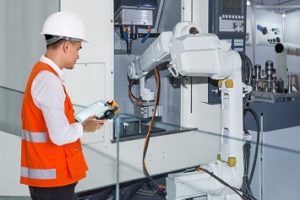In 2007, a multicamera system called SafetyEYE was developed that monitored the work space around industrial robots, enabling them to adjust their behavior when a human worker entered their work space. The innovation made it possible for humans and robots to work together in a way that they never could before. In 2009, the first collaborative robots appeared in Denmark and Germany; by 2012, mobile robots were sharing work spaces with humans in the United States at a BMW factory in Spartanburg, South Carolina.
Five years later, mobile robot systems are fully developed and robots move freely through work spaces alongside humans, save for one critical gap: There is no standard addressing industrial mobile robot safety. That’s why the Robotic Industries Association (RIA) has formed a joint committee with the American National Standards Institute (ANSI) to write and publish a new standard, R15.08, Industrial Mobile Robot Safety.
Two Become One
At the current time, there are two consensus standards applicable to the technology that goes into a single mobile robot, and they were both most recently updated in 2012.
The ANSI/ITSDF B56.5-2012, Safety Standard for Driverless, Automatic Guided Industrial Vehicles and Automated Functions of Manned Industrial Vehicles, developed by the Industrial Truck Standards Development Foundation, is the most closely applicable standard for mobile platforms. But it is written for automatic guided vehicles (AGVs) that move along a path of magnetic tracks or navigational beacons imbedded in the workplace floor. Mobile industrial robots, in contrast, are self-guided and can change their routes as needed, making them far more flexible but also increasing their potential interactions with human workers.
The ANSI/RIA R15.06-2012, Industrial Robots and Robot Systems—Safety Requirements, developed by the RIA, covers the manipulative elements of a robot. It is primarily written for fixed robotics systems.
In 2013, the National Institute of Standards and Technology (NIST), part of the U.S. Department of Commerce, conducted an analysis of the two standards relative to the new mobile industrial robotic technologies, identifying gaps and conflicts in the two standards. Areas that will have to be addressed in the new standard include:
- Presence-detection standards. Robots must be able to reliably detect humans in the shared space. In addition, presence-detection systems must account for objects that project beyond the protected zones, like large objects carried by mobile robots that extend beyond their range of sensitivity. The standard should specify the best available methods for presence detection.
- Communication between the mobile base and the robot manipulator (the “arm”). Mobile bases are usually programmed to stop before a collision occurs—but manipulators typically have no such programming. The base and the manipulator must be able to communicate so that the whole device will fail to safe rather than harm a human worker.
- Stopping distances. The mobile base and the manipulator may move at different speeds, which can change the protective stopping distance; the movement of both sections must be accounted for.
The first two parts of the new standard will address robot manufacturers and integrators; the draft of that document is supposed to be ready for comments by the end of 2017, with an expected final publication date of 2019.

